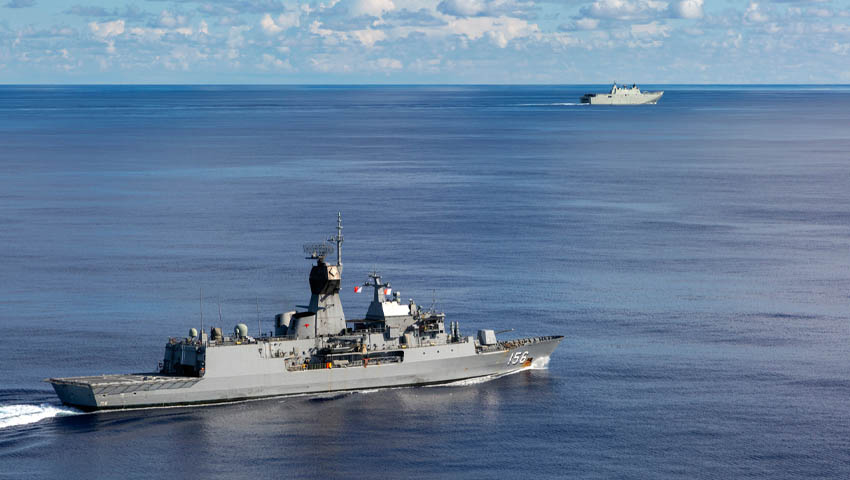The Royal Australian Navy frigate HMAS Toowoomba has commenced it's return trip to Australia following the successful completion of a six-month deployment to the Middle East.
To continue reading the rest of this article, please log in.
Create free account to get unlimited news articles and more!
Toowoomba has concluded her assignment to Joint Task Force 633 as part of Operation MANITOU, conducting counter-terrorism and maritime security operations, operating in the waters stretching from the Southern Arabian Gulf to the Gulf of Aden.
The ship made a significant intercept during the deployment, netting more than 3,000 kilograms of illegal narcotics.
Commander Joint Task Force 633, Major General Susan Coyle recognised Toowoomba’s outstanding performance during trying times amid the COVID-19 pandemic.
MAJGEN Coyle congratulated the crew of Toowoomba on their conduct and performance during the chaotic period of time, saying, "The ship’s company in Toowoomba have executed their duties to the highest standard in support of the Combined Maritime Forces and as the inaugural Australian ship in support of the International Maritime Security Construct."
Commanding Officer HMAS Toowoomba, Commander Dylan Phillips, said he was proud of his crew’s achievements and looking forward to returning home in the coming weeks.
"We have enhanced our relationships in the region, as well as having an impact on terrorist funding lines through the interception and disposal of illegal drugs. Toowoomba intercepted an illegal shipment of hashish and heroin hidden inside a suspect vessel on 19 March. Our crew worked tirelessly throughout the day and well into the night to search the vessel, before seizing and destroying over three tonnes of drugs," CMDR Phillips said.
Toowoomba travelled more than 27,450 nautical miles and visited numerous ports, before COVID-19 impacts, throughout the region during the deployment.
CMDR Phillips added, "Toowoomba’s contribution to the Combined Maritime Forces and International Maritime Security Construct has been highly successful due to our ship’s capability and the commitment of our highly trained crew over a sustained period on operations. I could not be prouder of everyone’s effort."
Toowoomba’s efforts supported the safe passage of more than 180 International Maritime Security Construct flagged merchant vessels by providing overwatch of their transits through the Southern Arabian Gulf, Strait of Hormuz and Gulf of Oman.
Toowoomba was the 68th rotation of an Australian warship to the Middle East since 1990, which has upheld Australia’s reputation as an outstanding and reliable coalition partner.
CMF conducts maritime security operations, counters terrorism and narcotics smuggling in maritime areas of responsibility; works with regional and other partners to improve overall security and stability; helps strengthen regional nations’ maritime capabilities and, when requested, responds to environmental and humanitarian crises.
The CMF, however, does not prescribe a specific level of participation from any member nation, nor is any CMF nation asked to carry out any duty that it is unwilling to conduct. The contribution from each country, therefore, varies depending on its ability to contribute assets and the availability of those assets at any given time.
The 33 nations that comprise CMF are not bound by either a fixed political or military mandate. CMF is a flexible organisation. Contributions can vary from the provision of a liaison officer at CMF HQ in Bahrain to the deployment of warships or maritime reconnaissance aircraft.
CMF can also call on warships not explicitly assigned to CMF to give associated support. This allows a warship to offer assistance to CMF while concurrently undertaking national tasking.
HMAS Toowoomba is the seventh of eight Anzac Class frigates built by Tenix Defence Systems at Williamstown, Victoria, for the Royal Australian Navy. The design is based on the German MEKO 200 frigate.
Toowoomba is a long-range frigate capable of air defence, surface and undersea warfare, surveillance, reconnaissance and interdiction. Toowoomba’s combat capabilities have been significantly improved under the Anti-Ship Missile Defence upgrade program, a world-class program that provides an enhanced sensor and weapons systems capability.
The upgrade showcases Australian design and integration capability, with new phased array radar technology designed by CEA Technologies in Canberra, upgrades to combat systems performed by Saab Systems in South Australia, and platform integration design by BAE Systems in Victoria.
Toowoomba is fitted with an advanced package of air and surface surveillance radars, omni-directional hull-mounted sonar and electronic support systems that interface with the 9LV453 Mk3E combat data system. The ship can counter simultaneous threats from aircraft, surface vessels and submarines.
The ship can embark Navy’s latest multi-role Sikorsky/Lockheed Martin MH-60R Seahawk helicopter, which has enhanced anti-submarine, anti-surface warfare and search and rescue capabilities. Embarkation of a helicopter also provides the ship with the capability to deliver air-launched missiles and torpedoes.
HMAS Toowoomba is the second RAN ship to bear the name of Queensland’s inland city. HMAS Toowoomba (I) was one of 60 Bathurst Class minesweeping corvettes built in Australia during the Second World War as part of the Commonwealth government’s wartime shipbuilding program.

 Login
Login







